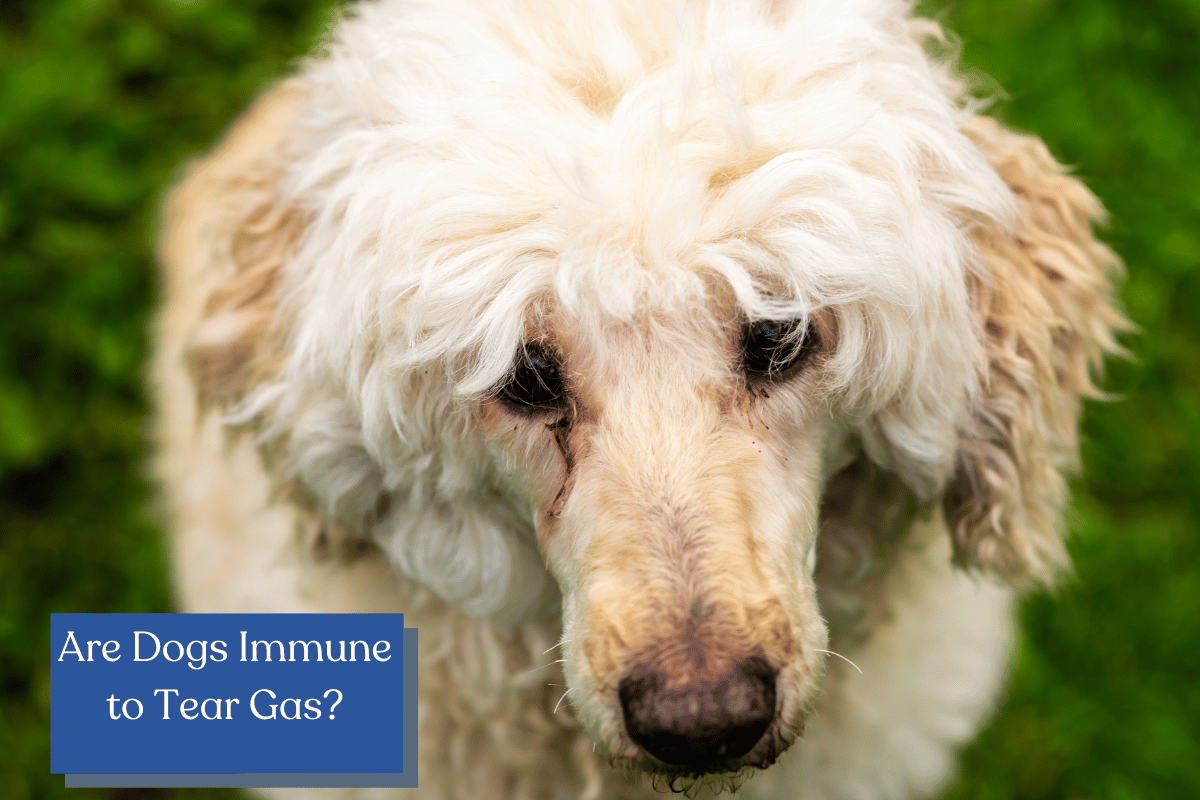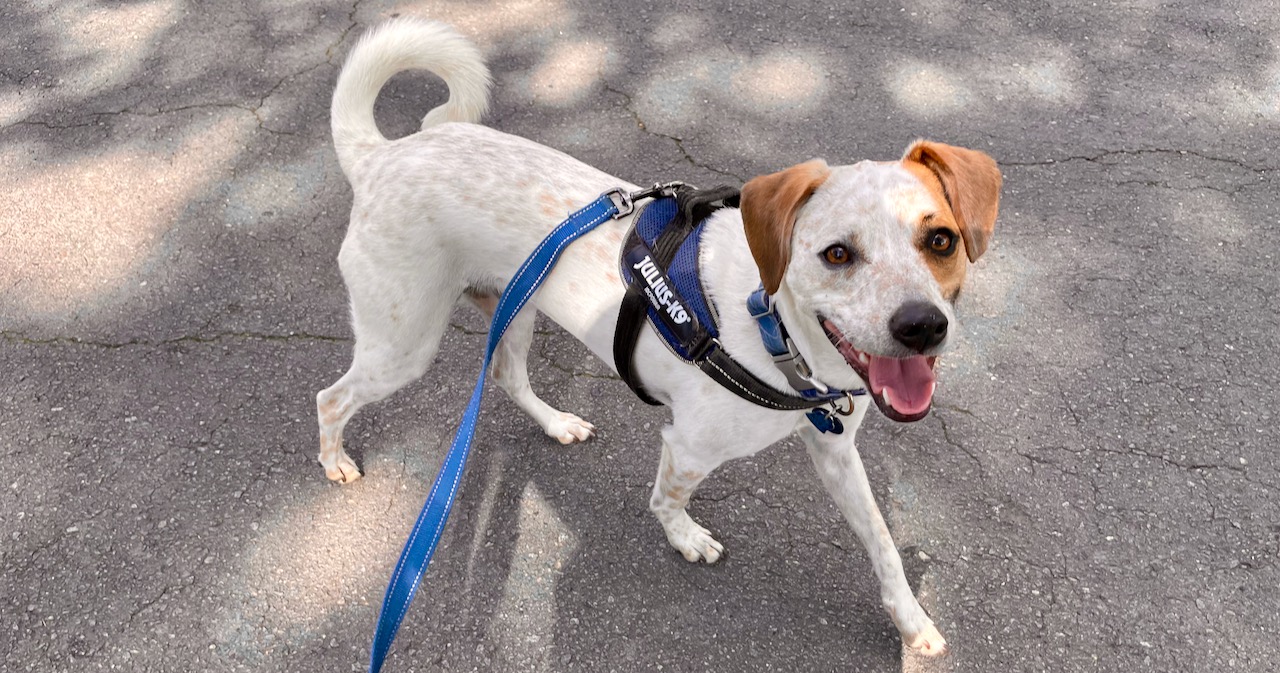Tear gas has become a weapon that strikes fear in people with a simple mention of it. The notoriety comes from how prevalent its usage has become recently. Therefore, it makes sense why pet owners often wonder whether are dogs immune to tear gas.
So I thought creating an article on this topic would be a good idea. In doing so, I’ll help you understand its impact, side effects, and how to deal with an exposure situation. You’ll soon become an expert on the relationship between this weapon and pets.
But before I look further into whether dogs are immune, I must ensure you can identify it. After all, the following information won’t do any good if you don’t know the basics of tear gas. It’s the first step in understanding everything about this horrifying weapon.
What is Tear Gas?
Tear gas is a preferred chemical weapon for police when dealing with riots and protests. It’s been around for a long time but has gained more popularity with its effectiveness. Nothing makes people stop protesting in a more efficient way than hitting with tear gas.
Of course, this effectiveness results from tear gas being a horrible weapon. It’s a painful weapon that leaves anyone hit with it in significant pain. I wouldn’t wish its effects on anyone, especially my dogs.
In people, it causes symptoms like temporary skin irritation, blindness, and generalized pain. The only good news is tear gas isn’t a lethal weapon when used correctly. But it can become a bit dicey if ingested or inhaled.
Considering the pain it causes in people, it’d be logical to think it would have similar adverse effects on our dogs. It’s a topic that our next section will answer in full detail.
Are Dogs Immune to Tear Gas?
Someone started a myth among the dog community about canines being tear gas immune. It has spread like wildfire but isn’t based on research. In other words, dogs aren’t immune to this weapon as it’ll affect them as it would human beings.
So don’t believe anyone who tells you differently concerning this topic. Some dogs are even more affected by tear gas than humans. For instance, canines with short noses, like French Bulldogs or Pugs, have a significant disadvantage. Their nostrils are closer to the ground, making them more vulnerable to tear gas.
In these cases, the provided side effects can arrive quickly. I wouldn’t wait a second before taking your dog to the vet. The longer dogs continue getting hit with tear gas exposure, the worse these side effects will get.
It can bring severe consequences if the exposure continues longer than 30 minutes. These situations can result in a dog dying or have long-term side effects. It’s another reason owners should avoid putting their dogs in any position where tear gas exposure is possible.

5 Common Side Effects of Tear Gas on Dogs
I’ve now established that tear gas does cause side effects for dogs. But it’s time to look more deeply at the side effect reactions to ensure owners can identify them. From there, it’ll become much easier to know what’s happening, contact a vet, and have them address it.
1. Coughing
One of the first side effects to appear will be coughing. So if you’ve been around tear gas and your dog starts coughing up their lungs, exposure is a high possibility. Your next step would be addressing it immediately, as this constant coughing can result in more severe conditions.
For instance, pneumonia would be a possibility if this coughing is left untreated. This condition is a nightmare for both owners and dogs. It’s a much better idea to figure out how to treat this coughing the moment it presents itself.
2. Eye Irritation and Excessive Tearing
The primary calling card for tear gas is its ability to cause severe eye irritation. It’s what makes this weapon so effective. Let’s be honest; it’s hard to think of a more annoying issue than something wrong with your eye. I can’t imagine it being any different with dogs.
As for identifiable signs, indicators of eye irritation are redness and excessive tearing. Both will be very noticeable to any owner looking for them.
3. Difficulty Breathing
I don’t wish this symptom on any dog owners. There isn’t anything more scary than seeing your dog having difficulty catching their breath or breathing correctly. After all, it represents a life-threatening problem for your pup.
In this situation, owners shouldn’t waste any time and get them to a vet or other medical personnel ASAP. Every second counts!
4. Sneezing
An overlooked side effort of tear gas is sneezing. It certainly isn’t the first thing people associate with exposure to this weapon. However, it’ll present with eye irritation to make your dog’s day even more annoying.
5. Vomiting
Your dog’s body will do whatever it can to remove the tear gas from its body. One of their primary defense mechanisms is vomiting to remove the issue-causing substance. So it’s common to see dogs upchuck their lunch when suffering from tear gas exposure.
Of course, it won’t do your dog much good. But it’s still a notable sign to indicate something is seriously wrong with the canine.
How to Help a Dog Suffering From Tear Gas Exposure
Owners can do several things to help a dog suffering from tear gas exposure. Here’s a look at several tips to help you and your dog through this traumatic experience:
1. Located Fresh Air Away from Tear Gas
After getting tear gassed, the first move should be getting away from additional exposure. You’ll want to find an area with fresh, clean air to help reduce its effect on your dog. It’ll let you plan the next move without worrying about having more tear gas shoved in your face.
I’d also suggest doing whatever’s necessary to calm yourself. It’s vital to avoid panicking, or your dog will pick up on this anxiousness and become stressed. It’ll go a long way in ensuring this situation doesn’t get any worse than necessary.
2. Rinse Out Your Dog’s Eyes and Face
Rinsing your dog’s face and eyes can do wonders after the tear gas exposure. I’d recommend using room-temperature water and damping cloth for this process. It’s the safest method and won’t make it worse.
More importantly, this rinsing should flush out the tear gas and stop any burning sensation. It makes your dog feel much more comfortable after such a traumatic event.
3. Give Your Dog Some Water to Drink
Any dog exposed to tear gas can result in a wicked case of dehydration. But offering some water to drink can help mitigate those symptoms. You could also give them ice cubes to lick, which offers similar results.
I’d only caution against providing too much water. It might sound weird, but too much water can trigger your dog to vomit. So please prevent your dog from drinking an entire bowl because they will if left to their own devices.
4. Get Medical Attention Immediately
Tear gas exposure for a dog is an emergency. Getting your dog some medical attention ASAP is essential to avoid long-term consequences. So do whatever is possible to get them into a vet’s office or somewhere with a person with animal expertise.
It doesn’t even have to be your traditional vet office. If there’s a closer animal hospital, take your dog in there and tell them what happened. They should address the tear gas exposure without hesitation because the situation is serious.
From there, this entire event should be dealt with rather quickly. Your dog shouldn’t have trouble rebounding from the exposure after proper treatment.
5. Use Prevention Measures to Avoid Future Issues
The best defense against tear gas exposure is prevention. So do your best to keep your dog away from areas where it’s a possibility. It’s the simplest way to ensure this nightmare never occurs or happens again. In other words, keep your dog at home if you plan on participating in a protest.
Another critical prevention measure is keeping them inside during riots within your area. There’s no reason to risk tear gas exposure unless necessary. Moreover, walking them on a leash at all times is an excellent way to minimize this threat.
Conclusion
So the answer to whether are dogs immune to tear gas is a resounding no. This chemical weapon affects our pouches as much or even more than humans. It’ll make your dog cough, suffer eye irritation, sneeze, vomit, and have trouble breathing.
As a result, owners must do their best to avoid situations where tear gas exposure is possible. It means keeping your dog inside or at home when protests and riots happen. Your dog doesn’t need to be on the front lines.
Let me know if you have more concerns or questions in our comment section. After all, tear gas exposure is a frightening and traumatic experience. So I’d love to help anyone who needs further assistance preparing or dealing with this possibility.




